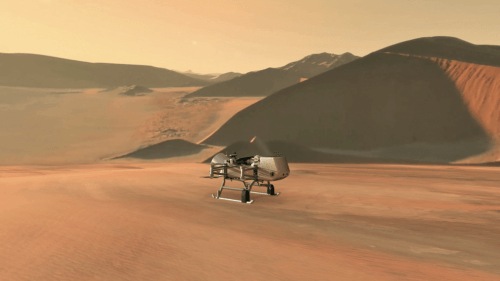NASA announced last Thursday that it has chosen its next mission to the outer solar system, the landing of a rover that will fly between various sites on Saturn's moon Titan and investigate whether life has formed there, and if so, to what level it has developed so far

NASA announced last Thursday that it has chosen its next mission to the outer solar system, landing a rover that will fly between various sites on Saturn's moon Titan and investigate whether life has formed there, and if so, to what level it has developed so far.
So far, humanity has launched stationary landers - those that explored the point where they landed, as well as all-terrain vehicles mainly to Mars. Now NASA is trying for the first time a technology that has developed in recent years in the civilian market - drones.
Dragonfly - a rover to Saturn's mysterious moon, Titan
"Dragonfly" (Dragonfly - Shapirit in Hebrew) is undoubtedly the boldest proposal among the 12 proposals submitted to the competition. The proposal seeks to land on Saturn's moon Titan a double quadcopter type glider (having four upper rotors and four lower rotors - the reason for the name of the glider, since dragonflies have two pairs of wings). If he chooses, he will expected reach Titan only in 2034.
Titan is the largest moon of the gas giant Saturn, which, its rings and its many moons were studied until recently by the Cassini probe, who ended her life crashing into Saturn on September 15, 2017. Cassini was the first spacecraft to see through the heavy haze in Titan's dense atmosphere, which makes it orange and dim in visible light. The spacecraft also released the European probe Huygens, which landed on the moon in 2005 and briefly operated on its surface. These discovered, among other things, that at its poles there are huge lakes of liquid methane and ethane; Dunes of "sand" made of complex hydrocarbon compounds originating from the abundant methane in the atmosphere; And beneath its surface, which consists of frozen water ice at a temperature of about minus 180 degrees Celsius, hides a global ocean of liquid water.
Elizabeth Tortell, the proposal's principal investigator from the Applied Physics Laboratory (APL) at Johns Hopkins University in Maryland, explained the purpose of the mission: "Cassini has mapped Titan in quite a bit of detail, which is very effective for identifying potential landing sites and knowing where the best places to land on Titan are, to make measurements to understand the organic chemistry on Titan's surface. In addition, the Huygens lander landed on Titan at a similar time of year, and at a similar latitude, to when and where Dragonfly will land, so we also characterized the atmosphere at that time. But these tasks left us with many fundamental questions. We do not know the basic composition of Titan's solid surface. We have some information from spectroscopic characterization from orbit [by Cassini], we have some information from the Huygens probe, but none of them were designed or capable of making detailed measurements of the rich kind of organic chemistry that we know is going on there. So Dragonfly is planned to return, build on what we learned from Cassini and Huygens and answer the basic questions that remain about Titan."

In order to study as many different geological sites on Titan as possible, which will be spread over distances of hundreds of kilometers, and thus increase the scientific return of the mission, the researchers want to send a rover to the surface of the mysterious moon. Titan is the only moon in the solar system with a dense and significant atmosphere. In fact, the atmospheric pressure on its surface is slightly greater than that on Earth. Together with its low gravity (14% of Earth's) - Titan provides ideal conditions for aviation.
At Titan's enormous distance from the Sun, along with an atmosphere that hides the drop of light that reaches it, the rover will not be able to use solar energy to operate. Instead Dragonfly will use theThermoelectric radioisotope generator (Type MMRTG), which produces electricity based on the heat emitted by radioactive material. A major advantage of such a generator is its ability to operate for many years. Other spacecraft that used such a generator, for example, are Cassini which operated for 20 years (and could have operated for many more years had it not been sent to a deliberate death inside Saturn) and the Voyager spacecraft, which are still active after 40 years.
To study Titan's atmosphere, surface and internal structure, Dragonfly will make several types of measurements: a mass spectrometer will use samples from the surface and atmosphere to determine their chemical composition; A gamma ray spectrometer will measure the general chemical composition of the surface; A system of atmospheric sensors will measure the atmospheric pressure, temperature and winds; Seismographic measurements will study Titan's internal structure; And of course - an array of cameras will characterize the exotic geology of Titan.

Titan's enormous distance from Earth will require the rover to be able to operate almost completely autonomously. Unlike the European Huygens lander that operated for a very short time on Titan's surface, and communicated with Earth via its mother spacecraft Cassini, Dragonfly will communicate with Earth directly.
The mission will be managed by the Applied Physics Laboratory (APL) and will also be built by it, in collaboration with researchers from Penn State University in Pennsylvania, who have experience in designing rotorcraft, and who have already built a model of the drone proposed as part of the initial proposal process.
Thanks to Elisef Kosman
More of the topic in Hayadan:

3 תגובות
We want a certain time of the year, which will be the easiest to reach from Earth
I don't understand the arrival time - 15 years
Cassini arrived after 7 years (97-04).
In 8 years technology is developing a lot
Did you land a drone that would light up? Isn't it better if he skips it?